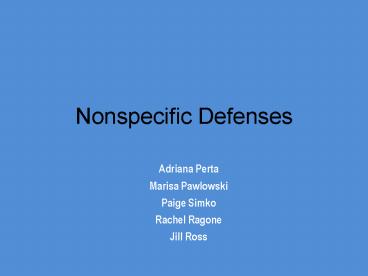Nonspecific Defenses PowerPoint PPT Presentation
1 / 9
Title: Nonspecific Defenses
1
Nonspecific Defenses
- Adriana Perta
- Marisa Pawlowski
- Paige Simko
- Rachel Ragone
- Jill Ross
2
Nonspecific Defenses
- Occur automatically because they are innate
- No memory is involved- no recognition that this
same intruder has been attacked before - Barriers to entry, the inflammatory response,
phagocytes and natural killer cells, and
protective proteins are types of nonspecific
defenses
3
Immunity
- The bodys capability to remove foreign
substances and to kill pathogens and cancer cells - Involves both nonspecific defenses and specific
defenses
4
Barriers to Entry
- Include nonchemical barriers such as the skin and
the mucous membranes lining the respiratory,
digestive, and urinary tracts serve as
mechanical barriers to entry by pathogens - Also include antimicrobial molecules (ex oil
gland secretions contain chemicals that weaken or
kill certain bacteria on the skin) - The stomach has an acidic pH, which inhibits the
growth of or kills many types of bacteria
5
Inflammatory Response(refer to page 637 figure
35.3)
- When tissue is damaged by physical or chemical
agents or by pathogens, a series of events occur - An inflamed area has four outward signs redness,
heat, swelling, and pain - These signs are due to capillary changes in the
damaged area - Histamine a chemical signal, released by damaged
tissue cells and mast cells - Mast cells a type of white blood cell in
tissues, cause capillaries to dilate and become
more permeable - Some inflammatory responses trigger fever, the
onset being controlled by the brain - The fever serves to inhibit the growth of some
microorganisms, promotes accelerated tissue
repair, stimulates immune cells to divide and
increases the production of viral-fighting
interferon
6
Chronic Inflammation
- One that persists for weeks or longer
- Often treated by administering anti-inflammatory
agents, such as aspirin, ibuprofen, or cortisone - These medications act against the chemical
signals, such as histamines, that bring about an
inflammation - Chronic inflammation is thought to play a role in
many human illnesses - May lead to heart attacks, may destroy nerve
cells in the brains of Alzheimer patients, can
also be involved in the development of diabetes
in obese individuals - Autoimmune diseases involve inflammation, but in
these cases specific immunity seems to be the
leading cause - A healthy diet, exercise, and good dental hygiene
can reduce the occurrence of inflammation and
help keep us well by reducing the occurrence of
chronic inflammation
7
Macrophages and Cytokines
- Macrophages in tissues, that devour many
pathogens and survive - Have receptors that allow them to recognize the
presence of pathogens - Release cytokines
- Cytokines chemical signals that stimulate other
white cells such as neutrophils and monocytes,
that then mature into macrophages
8
Natural Killer Cells
- Large, granular lymphocytes that kill
virus-infected cells and cancer cells by
cell-to-cell contact - Produce cytokines that stimulate these cells
- Congregate in the tonsils, lymph nodes, and
spleen - Look for a self protein on the bodys cell
- Not specific have no memory and their numbers
do not increase after stimulation occurs
9
Protective Proteins(refer to page 638 figure
35.4)
- Complement composed of a number of blood plasma
proteins - complement certain immune responses
- Involved in the inflammatory response because
certain complement proteins can bind to mast
cells and trigger histamine release - Some combine to form a membrane attack complex
that produces holes in the surface of bacteria
and viruses - Interferons proteins produced by virus-infected
cells as a warning to noninfected cells in the
area - Binds to receptors of noninfected cells, causing
them to prepare for a possible attack - Used as treatment in certain viral infections
like hepatitis C

